Annals of Emergency Medicine
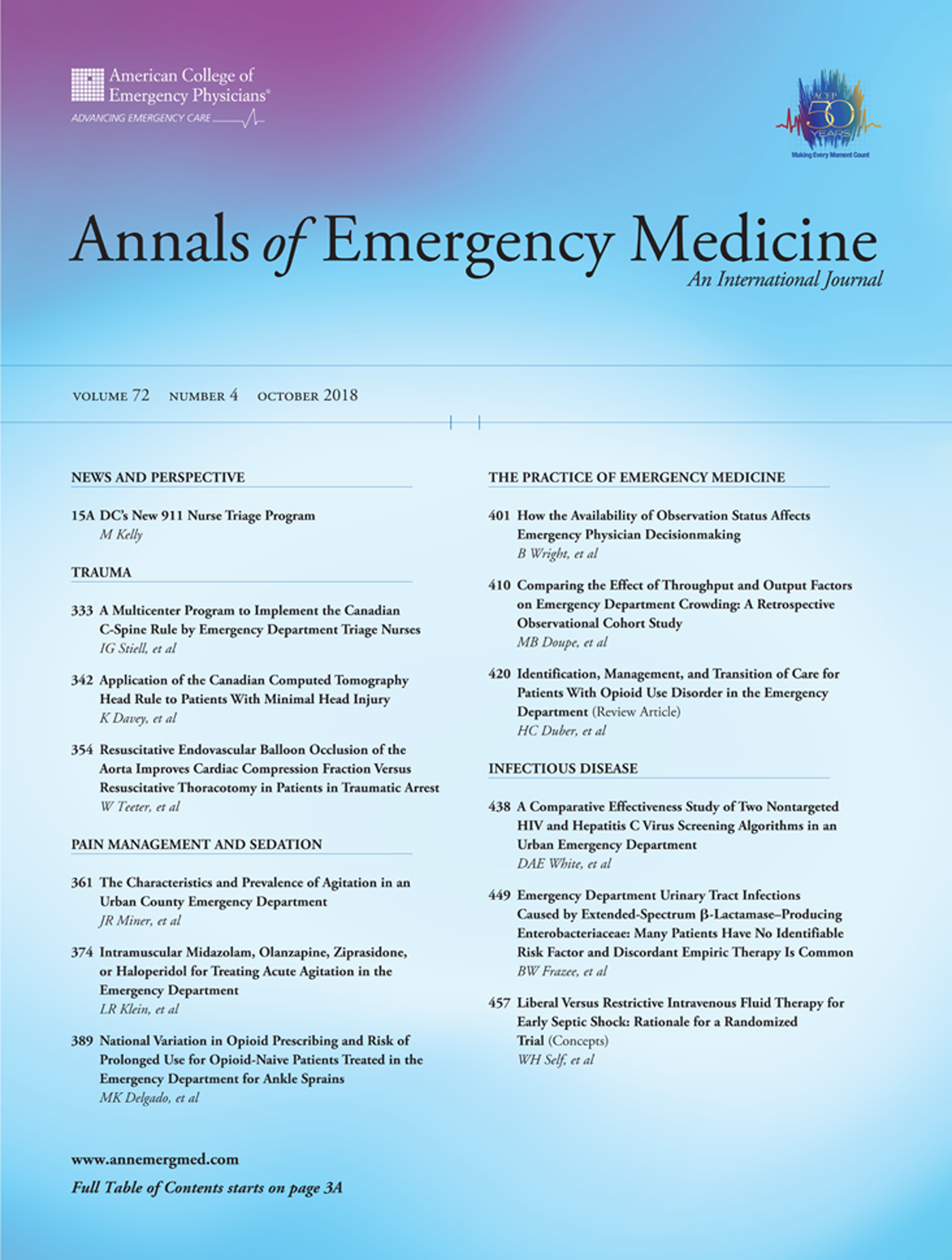
Official journal of the American College of Emergency Physicians
(The print version of this article has been scheduled for March 2019)
Oral Ondansetron Administration to Nondehydrated Children With Diarrhea and Associated Vomiting in Emergency Departments in Pakistan: A Randomized Controlled Trial
Stephen B. Freedman, Sajid B. Soofi, Andrew R. Willan, Sarah Williamson-Urquhart, Noshad Ali, Jianling Xie, Fady Dawoud, Zulfiqar A. Bhutta
https://doi.org/10.1016/j.annemergmed.2018.09.011
Study objective: We determine whether single-dose oral ondansetron administration to children with vomiting as a result of acute gastroenteritis without dehydration reduces administration of intravenous fluid rehydration.
Methods: In this 2-hospital, double-blind, placebo-controlled, emergency department–based, randomized trial conducted in Karachi Pakistan, we recruited children aged 0.5 to 5.0 years, without dehydration, who had diarrhea and greater than or equal to 1 episode of vomiting within 4 hours of arrival. Patients were randomly assigned (1:1), through an Internet-based randomization service using a stratified variable-block randomization scheme, to single-dose oral ondansetron or placebo. The primary endpoint was intravenous rehydration (administration of ≥20 mL/kg of an isotonic fluid during 4 hours) within 72 hours of randomization.
Results: Participant median age was 15 months (interquartile range 10 to 26) and 59.4% (372/626) were male patients. Intravenous rehydration use was 12.1% (38/314) and 11.9% (37/312) in the placebo and ondansetron groups, respectively (odds ratio 0.98; 95% confidence interval [CI] 0.60 to 1.61; difference 0.2%; 95% CI of the difference –4.9% to 5.4%). Bolus fluid administration occurred within 72 hours of randomization in 10.8% (34/314) and 10.3% (27/312) of children administered placebo and ondansetron, respectively (odds ratio 0.95; 95% CI 0.56 to 1.59). A multivariable regression model fitted with treatment group and adjusted for antiemetic administration, antibiotics, zinc prerandomization, and vomiting frequency prerandomization yielded similar results (odds ratio 0.91; 95% CI 0.55 to 1.53). There was no interaction between treatment group and age, greater than or equal to 3 stools in the preceding 24 hours, or greater than or equal to 3 vomiting episodes in the preceding 24 hours.
Conclusion: Oral administration of a single dose of ondansetron did not result in a reduction in intravenous rehydration use. In children without dehydration, ondansetron does not improve clinical outcomes.
How to cite this article: Freedman, SB, Soofi, SB, Willan, AR, et al. Oral Ondansetron Administration to Nondehydrated Children With Diarrhea and Associated Vomiting in Emergency Departments in Pakistan: A Randomized Controlled Trial. 2018.
African journal of emergency medicine
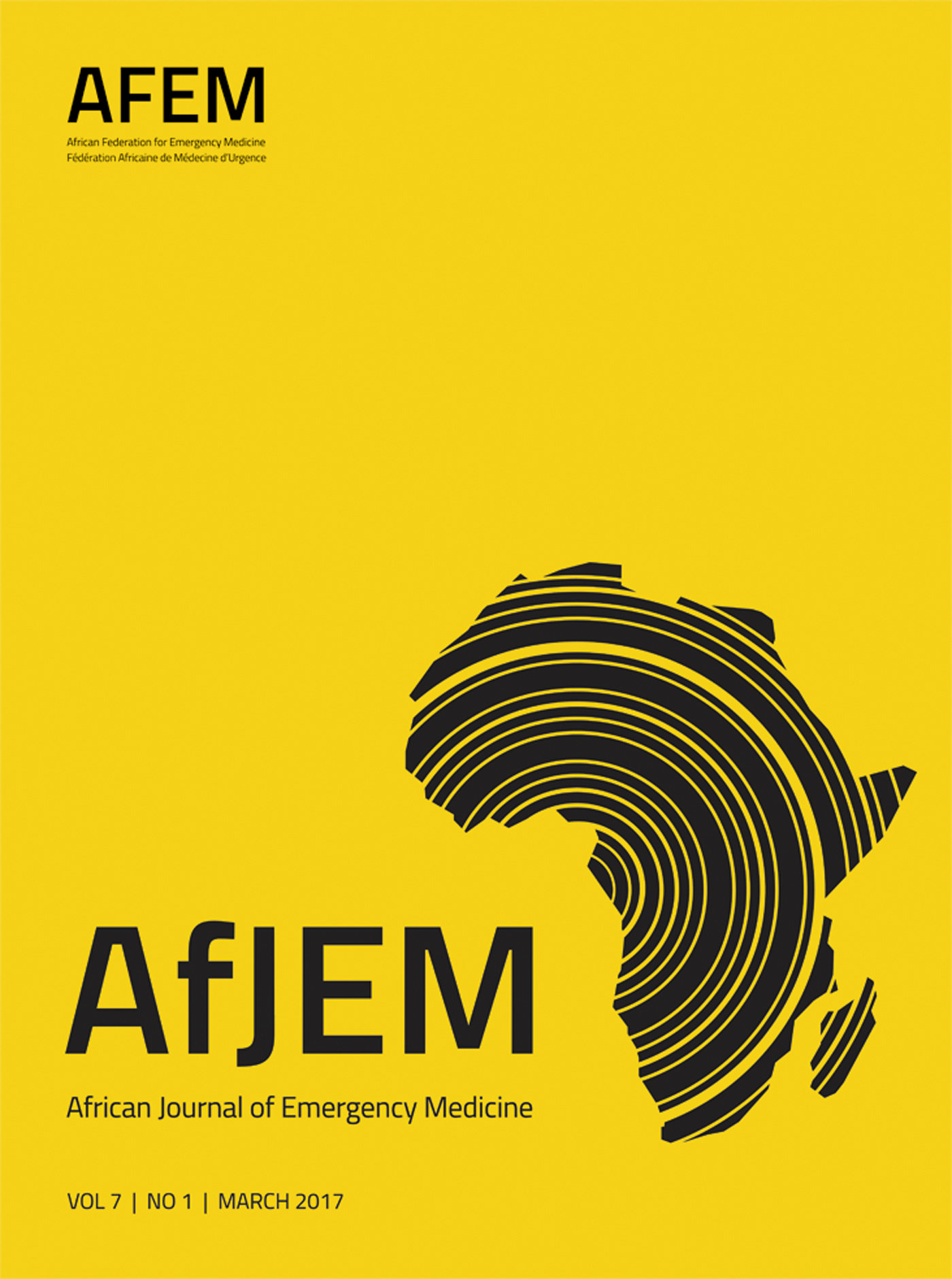
The official journal of the African Federation for Emergency Medicine, the Emergency Medicine Association of Tanzania, the Emergency Medicine Society of South Africa, the Egyptian Society of Emergency Medicine, the Libyan Emergency Medicine Association, the Ethiopian Society of Emergency Medicine Professionals, the Sudanese Emergency Medicine Society, the Society of Emergency Medicine Practitioners of Nigeria and the Rwanda Emergency Care Association
The burden of intentional self-poisoning on a district-level public Hospital in Cape Town, South Africa
Van Hoving DJ, Hunter LD, Gerber RJ, Lategan HJ, Marks CJ
Afr J Emerg Med 2018;8(3):79-83
https://doi.org/10.1016/j.afjem.2018.03.002
Introduction: Intentional self-poisoning is a significant part of the toxicological burden experienced by emergency centres. The aim of this study was to describe all adults presenting with intentional self-poisoning over a six-month period to the resuscitation unit of Khayelitsha Hospital, Cape Town.
Methods: Adult patients with a diagnosis of intentional self-poisoning between 1 November 2014 and 30 April 2015 were retrospectively analysed after eligible patients were obtained from the Khayelitsha Hospital Emergency Centre database. Missing data and variables not initially captured in the database were retrospectively collected by means of a chart review. Summary statistics were used to describe all variables.
Results: A total of 192 patients were included in the analysis. The mean age was 27.3years with the majority being female (n=132, 68.8%). HIV-infection was a comorbidity in 39 (20.3%) patients, while 13 (6.8%) previously attempted suicide. Presentations per day of the week were almost equally distributed while most patients presented after conventional office hours (n=152, 79.2%), were transported from home (n=124, 64.6%) and arrived by ambulance (n=126, 65.6%). Patients spend a median time of 3h37m in the resuscitation unit (interquartile range 1h 45m–7h 00m; maximum 65h 49m). Patient acuity on admission was mostly low according to both the Triage Early Warning Score (non-urgent n=100, 52.1%) and the Poison Severity Score (minor severity n=107, 55.7%). Pharmaceuticals were the most common type of toxin ingested (261/343, 76.1%), with paracetamol the most frequently ingested toxin (n=48, 25.0%). Eleven patients (5.7%) were intubated, 27 (14.1%) received N-acetylcysteine, and 18 (9.4%) received benzodiazepines. Fourteen (7.3%) patients were transferred to a higher level of care and four deaths (2%) were reported.
Discussion: Intentional self-poisoning patients place a significant burden on emergency centres. The high percentage of low-grade acuity patients managed in a high-acuity area is of concern and should be investigated further.
Reproduced with permission
Emergency Medicine Journal
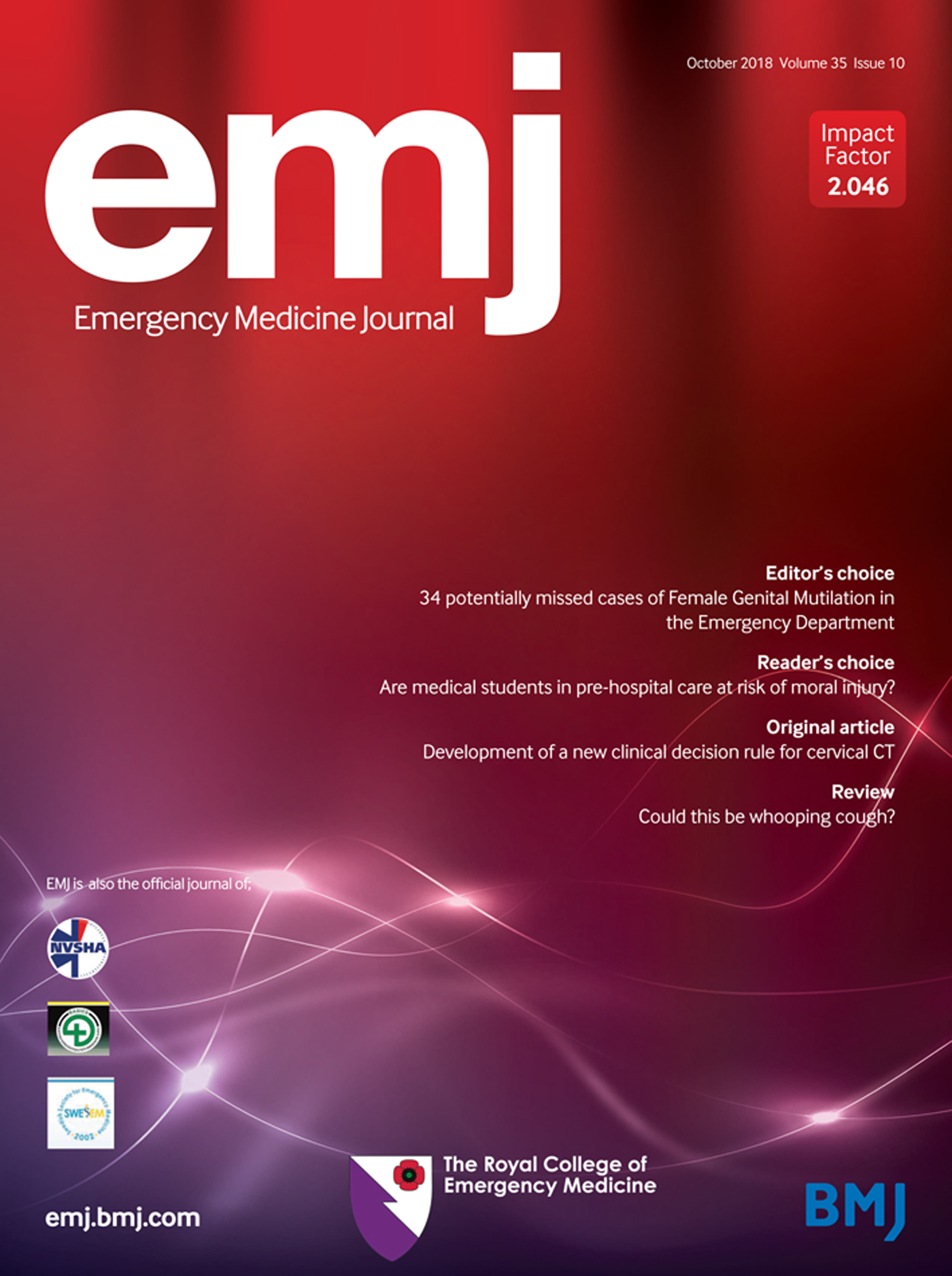
Official Journal of the Royal College of Emergency Medicine
Accuracy of NEXUS II head injury decision rule in children: a prospective PREDICT cohort study
Franz E Babl, Ed Oakley, Stuart R Dalziel, Meredith L Borland, Natalie Phillips, Amit Kochar, Sarah Dalton, John Alexander Cheek, Yuri Gilhotra, Jeremy Furyk, Jocelyn Neutze, Susan Donath, Stephen Hearps, Louise M Crowe, Marta Arpone, Silvia Bressan, Mark D Lyttle, For the Paediatric Research in Emergency Department International Collaborative (PREDICT)
http://dx.doi.org/10.1136/emermed-2017-207435
Objective: The National Emergency X-Radiography Utilisation Study II (NEXUS II) clinical decision rule (CDR) can be used to optimise the use of CT in children with head trauma. We set out to externally validate this CDR in a large cohort.
Methods: We performed a prospective observational study of patients aged <18 years presenting with head trauma of any severity to 10 Australian/New Zealand EDs. In a planned secondary analysis, we assessed the accuracy of the NEXUS II CDR (with 95% CI) to detect clinically important intracranial injury (ICI). We also assessed clinician accuracy without the rule.
Results: Of 20 137 total patients, we excluded 28 with suspected penetrating injury. Median age was 4.2 years. CTs were obtained in ED for 1962 (9.8%), of whom 377 (19.2%) had ICI as defined by NEXUS II. 74 (19.6% of ICI) patients underwent neurosurgery.
Sensitivity for ICI based on the NEXUS II CDR was 379/383 (99.0 (95% CI 97.3% to 99.7%)) and specificity was 9320/19 726 (47.2% (95% CI 46.5% to 47.9%)) for the total cohort. Sensitivity in the CT-only cohort was similar. Of the 18 022 children without CT in ED, 49.4% had at least one NEXUS II risk criterion. Sensitivity for ICI by the clinicians without the rule was 377/377 (100.0% (95% CI 99.0% to 100.0%)) and specificity was 18 147/19 732 (92.0% (95% CI 91.6% to 92.3%)).
Conclusions: NEXUS II had high sensitivity, similar to the derivation study. However, approximately half of unimaged patients were positive for NEXUS II risk criteria; this may result in an increased CT rate in a setting with high clinician accuracy.
Emergencias
http://emergencias.portalsemes.org/English
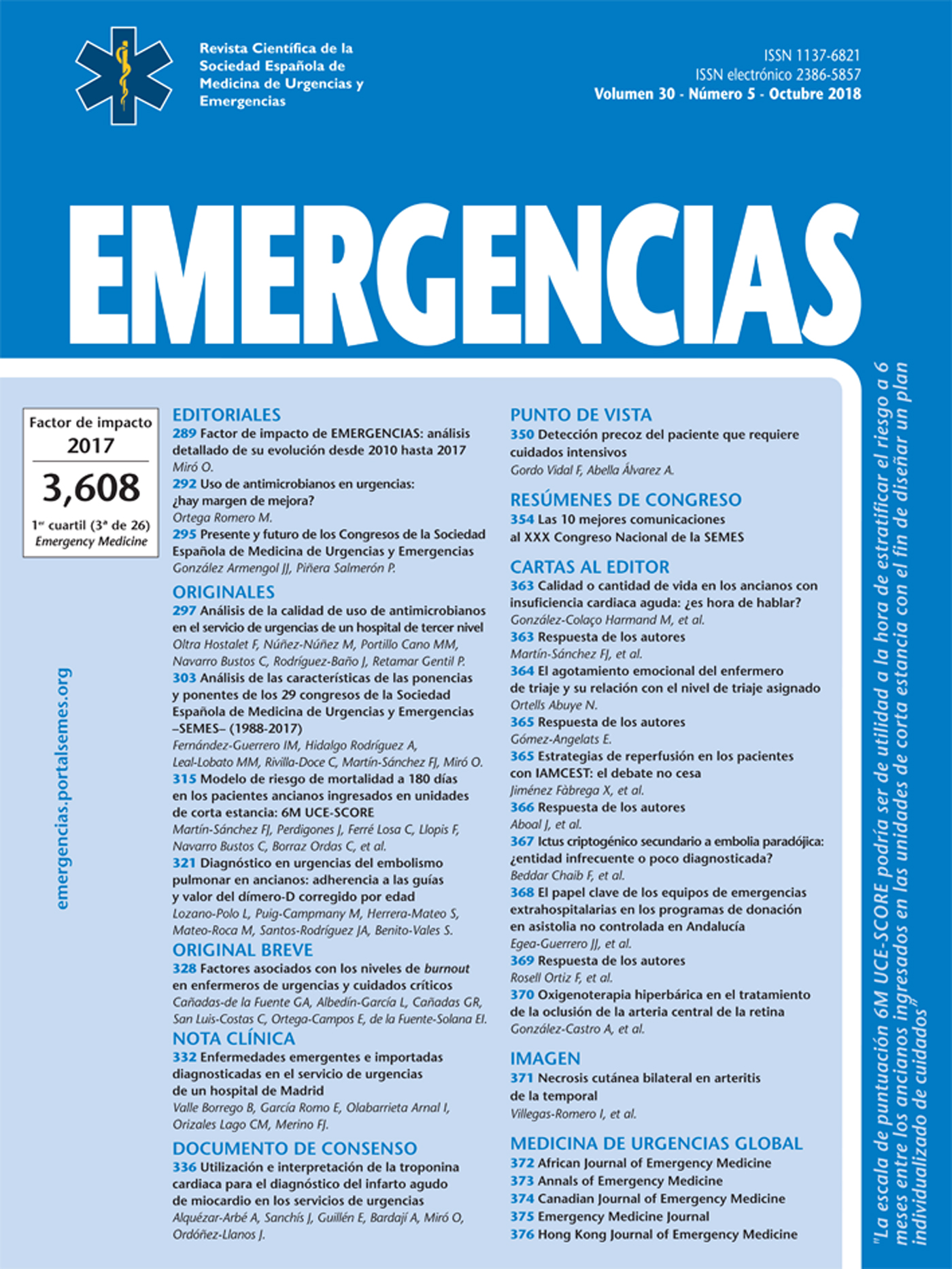
Official Journal of the Spanish Society of Emergency Medicine
Efficacy and safety of high-flow nasal cannula oxygen therapy in patients with acute heart failure
José Manuel Carratal, Salvador Díaz Lobato, Benjamin Brouzet, Patricio Más-Serrano, Begoña Espinosa, Pere Llorens.
Cited: Carratala JM, Díaz Lobato S, Brouzet B, Más-Serrano P, Espinosa B, Llorens P. Efficacy and safety of high-flow nasal cannula oxygen therapy in patients with acute heart failure. Emergencias. 2018;30:395-9.
Objectives: To evaluate the efficacy and safety of high-flow nasal cannula (HFNC) oxygen therapy in patients in acute respiratory failure due to acute heart failure (AHF) refractory to conventional oxygen therapy or noninvasive ventilation.
Methods: Prospective observational study of patients with AHF and respiratory failure attended in an emergency department whose condition worsened after they were admitted to a short-stay unit, leading to use of HFNCs. Efficacy was assessed using a modified Borg dyspnea scale and oxygenation variables on discharge from the emergency department. Data were recorded after 24 hours on conventional oxygen therapy and after 60 and 120 minutes and 24 hours of HFNC therapy. Safety outcomes were the degree of patient comfort and the frequency of adverse events.
Results: Forty-four patients with a mean (SD) age of 84 (7) years (75% women) were enrolled. Significant improvements were observed after HFNC oxygen therapy (baseline vs 60 and 120 minutes and baseline vs 24 hours) on clinical outcomes and oxygenation as well as decrease in respiratory frequency (P < .05). No significant changes in the partial pressure of carbon dioxide in arterial blood were detected. The most common side effect was feeling too warm (20.4%).
Conclusion: HFNC oxygen therapy offers a treatment alternative for patients with acute respiratory failure due to AHF.
Keywords: Acute heart failure. Hospital emergency health services. Short-stay unit. High-flow nasal cannula.
Hong Kong Journal of Emergency Medicine
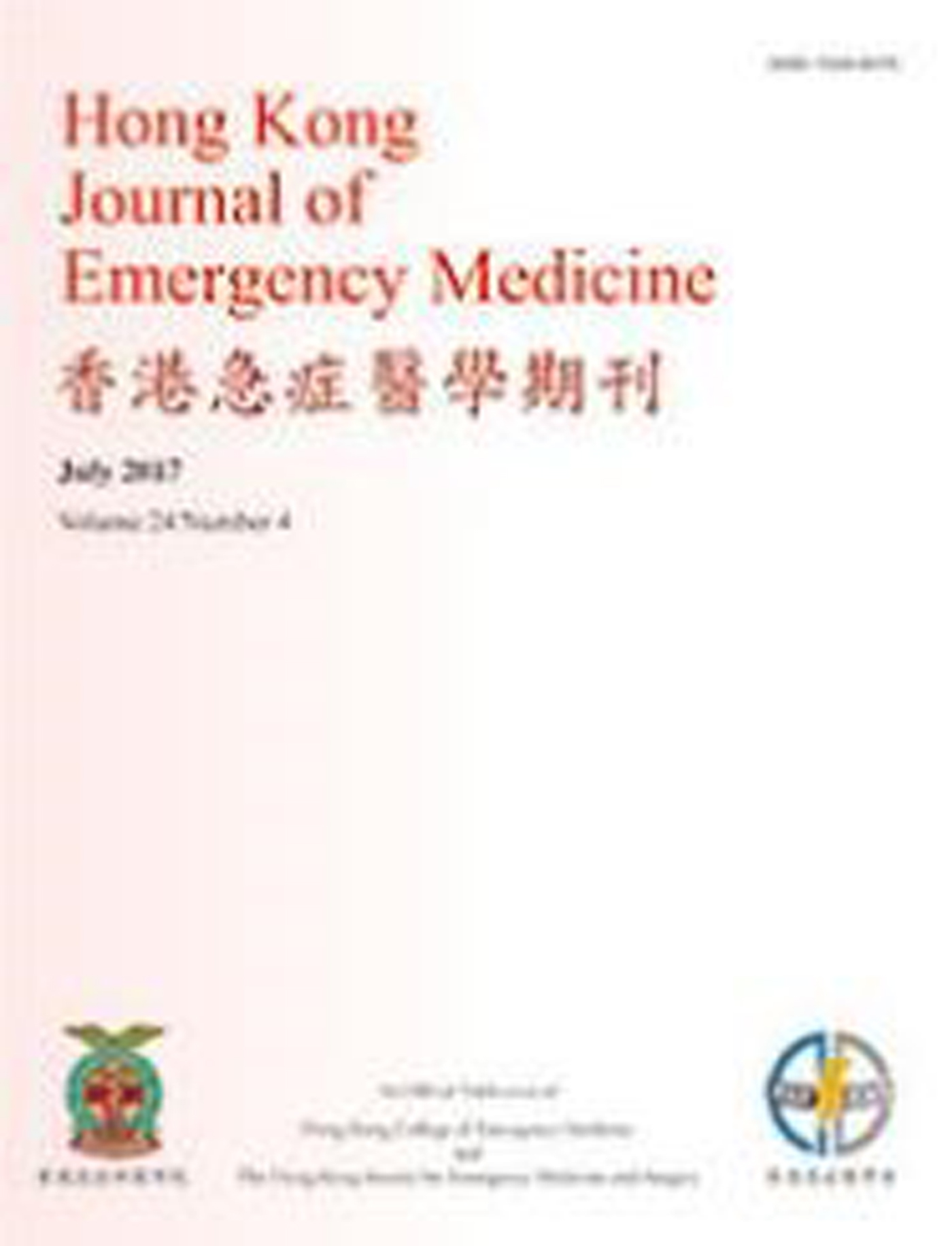
Official Journal of the Hong Kong College of Emergency Medicine
Investigation of risk factors of geriatric patients with significant brain injury from ground-level fall: A retrospective cohort study in a local Accident and Emergency Department setting
Wing Hong So, Ho Fai Chan and Mei Kwan Li
Background: Trauma was the fifth leading cause of death in Hong Kong in 2013.4 Injuries caused by falls ranked first in traumatic brain injury (TBI) cases among older adults (51%).5 Elderly trauma patients face an increased risk of adverse consequences6 from trauma compared with their younger counterparts, as advanced age itself is already a well-recognized risk factor for less favorable outcomes following trauma. Therefore, identifying factors associated with significant brain injury in geriatric patients in A&E triage is crucial in providing timely care to these patients.
Objectives: To identify the risk factors for geriatric patients with significant brain injury from ground-level falls and to formulate their association of risk factors with significant brain injury as a consequence from ground-level falls.
Methods: This was a retrospective study with data collected from the Clinical Data Analysis and Reporting System of Queen Mary Hospital from 1 January 2013 to 31 December 2015. A total of 1101 cases were identified.
Results: There were 76% of the recruited patients with a normal computed tomography scan. However, the remaining 24% had computed tomography scans indicative of brain injury. Severe head injuries were scored 3 -8 on the Glasgow Coma Scale and moderate head injuries were scored 9 -12. Respectively, these were 20 times (p = 0.005) and 5 times (p = 0.002) more likely to have positive computed tomography findings than patients with a Glasgow Coma Scale score from 13 to 15. Patients with loss of consciousness were two times more likely to have a positive computed tomography result than those without loss of consciousness (p = 0.001). Although warfarin use is a well-established risk factor for intracranial hemorrhage after head injury, in our dataset, the result was not statistically significant. However, the use of new oral anti-coagulants was associated with positive computed tomography findings with patients taking new oral anti-coagulants 2.3 times more likely to have positive computed tomography findings compared with those with no anticoagulant use (p = 0.033).
Conclusion: Early detection of patients with significant brain injury and aggressive management may prevent secondary injury from the complications of brain injury, hence improving patient mortality and morbidity, and reducing hospital stay and health care costs.
Keywords: Significant brain injury, ground-level fall, geriatrics




